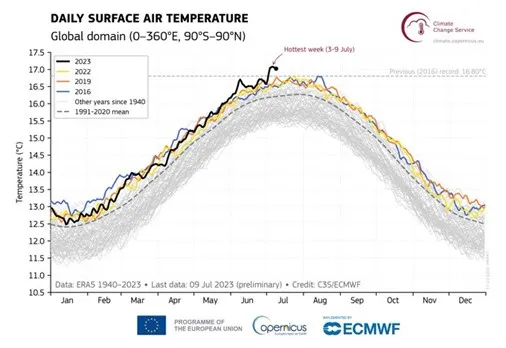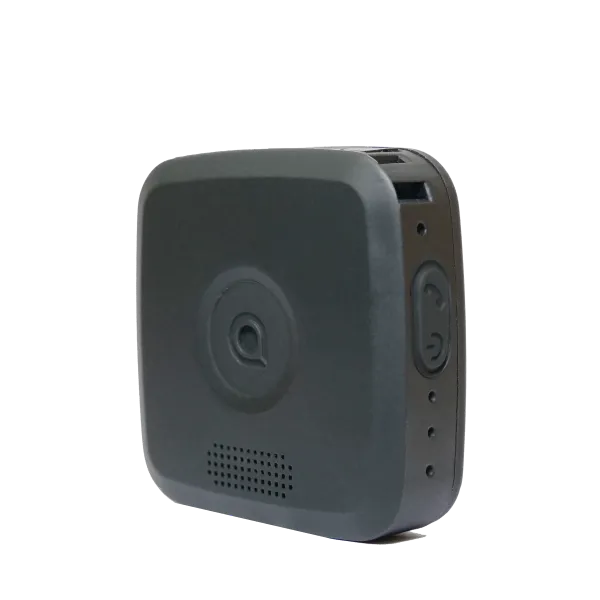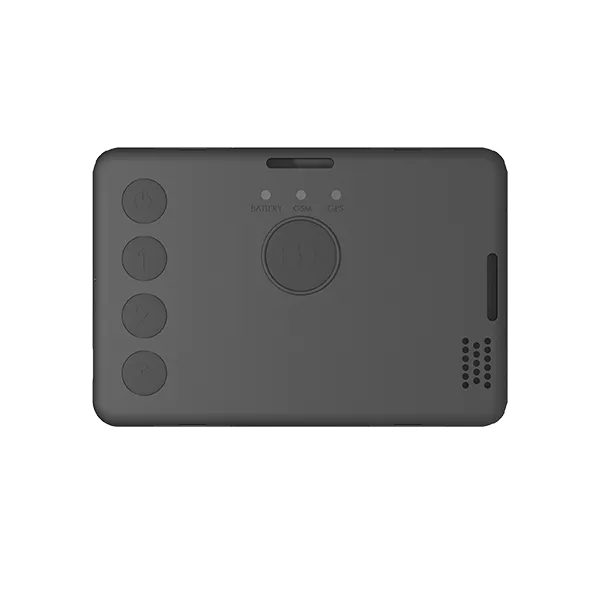How to Protect Lone Workers in Hot Weather: Safety Tips for Employers
Discover how to protect lone workers in extreme heat. Learn practical safety tips, legal responsibilities, and how SoloProtect devices help prevent heat stress and dehydration.

Hot Weather Safety for Lone Workers: Tips, Legal Guidance, and Tech Support
With rising global temperatures and more frequent heatwaves, employers must take steps to ensure lone worker safety in hot weather. From heat stress prevention to smart use of lone worker safety devices, this guide shares essential tips to help employers protect employees working outdoors, in remote areas, or without supervision during periods of extreme heat.
Why Employers Must Prioritise Worker Safety in Hot Weather
Each year, weather conditions continue to get hotter and more unpredictable due to global warming. Summers bring soaring temperatures that surpass previous records. According to the ERA dataset, the 7 days from the 3rd of July in 2023 were the hottest days on record globally. As workplace temperatures rise, hot weather risk assessments and preventative safety tools are more important than ever.

It’s also worth noting that, by 2030, more than 2% of total working hours worldwide are projected to be lost annually due to extreme heat, which is a productivity loss equivalent to 80 million full-time jobs. (ILO, 2019) IOSH Magazine. In 2020, hot days could have reduced productivity in Great Britain by £5.3 billion even with some adaptation measures in place. (Office for National Statistics)
This article is a resource for employers on how to protect lone, remote and high-risk workers in hot weather conditions, offering heat safety training and personal safety tips. We have included practical advice, regulatory information, and how SoloProtect can support lone workers through the hot weather period.
What Are the Risks of Working in Hot Weather? Heat Stress and Lone Worker Safety
The main risks workers face in hot weather are heat stress and dehydration. Heat stress can manifest in various ways, but common symptoms include an inability to concentrate, muscle cramps, heat rash, severe thirst, fainting, heat exhaustion and the most severe, heat stroke. For lone workers, heat stress can be particularly dangerous as these risks are not limited to outdoor environments; indoor workers can also be affected.
To mitigate these risks, employers should conduct thorough risk assessments that consider the following factors:
- Work rate
- Working climate
- Work clothing and PPE
- Workers’ age, body type and any medical factors.
The Health and Safety Executive (HSE) provides a helpful Thermal Comfort Checklist that can be used to guide assessments. Lone workers are especially vulnerable, as heat stress symptoms may go unnoticed without regular communication or monitoring.
Legal Responsibilities for Employers in Extreme Heat: UK Guidance for Worker Safety
What temperature is legally too hot to work? There is no specific law in the UK for minimum or maximum working temperatures. Government guidance suggests a minimum of 16ºC or 13ºC if employees are doing physical work, but there is no guidance for a maximum temperature limit.
Can employees refuse to work if it’s too hot? Yes, employees can stop working if they believe that their working environment is damaging their health. If they are then penalised, they can claim at an employment tribunal states the Standard in the article ‘UK Heatwave: When is it too hot to work?’
It’s in every employer’s best interest to conduct proper risk assessments and ensure all workers are supported, especially during heat waves. This includes understanding country-specific heat safety regulations for all workers. Using a lone worker device with check-in or man down alerts helps fulfil your duty of care under the Health and Safety at Work Act.
8 Practical Ways to Protect Lone and Remote Workers in Hot Weather
Below are proactive steps you can take to prevent heat-related illnesses, reduce employee risk, and maintain compliance during hot weather.
- Control the temperature: Ensure indoor workers have access to cool air and schedule outdoor work outside the hottest period of the day (12-3 pm.)
- Limit work rate and length of exposure: Offer shorter shifts and ensure access to shade and cool air.
- Prevent dehydration: Provide free water and encourage regular breaks
- Personal Protective Equipment: PPE can reduce the body’s ability to evaporate sweat so provide regular breaks for employees wearing PPE.
- Training: Offer heat safety education so employees can identify symptoms of heat stress.
- Risk Assessment: Conduct assessments for all workers, including retail, construction and healthcare workers.
- Dress code: Adjust dress codes to accommodate hot weather.
- Heat Alerts: Sign up for Met Office Heat Health Alert service to plan ahead.
How SoloProtect Devices Support Lone Worker Safety in Extreme Heat
In high-temperature environments, SoloProtect’s safety technology for lone workers offers reliable support, especially for those exposed to outdoor or unmonitored indoor heat risks. Our SoloProtect safety devices are designed to monitor, support and assist workers in hot weather conditions, using these features:
- Red Alert: A 24/7 panic button for heat emergencies that connects to our Monitoring Centre, where operators can triage the situation and summon emergency services if needed.
- Incapacitation Alarm: (commonly known as a Man Down Alarm) Critical in a heat stroke situation, detects when a user is immobile, triggering an emergency response. This is crucial for workers who could faint or suffer severe heat stroke.
- Check-In: Allows users to leave a short message about any risks, how they are feeling, and their location, including logging symptoms of dehydration or fatigue, so help can reach them quickly if they become ill.
These features are available on the SoloProtect ID Touch and Classic, SoloProtect Sheild, SoloProtect Curve and the SoloProtect mobile app for Android and IOS.
SoloProtect Mobile also comes with a Mass Notification System which can quickly alert workers of heat advisories and send out important updates such as hot weather alerts.
Additional Resources and Support
For more information on working in hot weather and heat stress prevention for lone workers, explore the following additional resources:
Health and Safety Executive- temperature guidance
ACAS- Tips for employers to manage hot weather at work
National Safety Council- Avoiding heat-related illnesses
As temperatures rise, the need to protect lone workers becomes increasingly critical. By understanding the risks, following legal guidelines, and implementing practical safety measures, employers can ensure their workers remain safe and productive during seasonal hot weather. SoloProtect’s range of technology can provide the essential support and monitoring needed to manage heat exposure effectively. Contact SoloProtect today to learn more about our lone worker safety solutions and how we can support your lone workers.
Book a free demo, request a quote, or get answers to your questions:
- Book a Lone Worker Safety Demo →
- Get a No-obligation Quote →
- Contact Us →
- Call us: 0114 399 6000
Your message has been received and we will be in touch shortly.
Frequently Asked Questions
Frequently Asked Questions About Lone Worker Safety in Hot Weather
What are the legal responsibilities of employers during hot weather?
In the UK, there’s no legal maximum working temperature, but under the Health and Safety at Work etc. Act 1974, employers must ensure a safe working environment at all times — including during extreme heat. This means conducting hot weather risk assessments, providing access to drinking water, and adjusting workloads or shift times to reduce heat exposure. Failure to take reasonable steps may breach your duty of care to employees.
What are the main signs of heat stress lone workers should watch for?
Heat stress symptoms can include dizziness, fatigue, nausea, excessive sweating, muscle cramps, or confusion. If left untreated, it can lead to heat exhaustion or heat stroke, which is life-threatening. Lone workers are especially at risk as they may not have colleagues nearby to spot early warning signs. Employers should provide training so employees can recognise symptoms and take action quickly.
How can employers prevent heat-related illnesses among lone workers?
Employers can prevent heat-related illnesses by:
- Providing adequate hydration and rest breaks
- Allowing work in cooler periods (early morning or late evening)
- Offering lightweight clothing and shade
- Using lone worker monitoring technology for check-ins and emergency support
- Delivering heat safety training for all staff
Combining these actions reduces the risk of dehydration, heat exhaustion, and non-compliance.
What temperature is considered too hot to work in the UK?
There’s no specific legal maximum temperature in the UK, but if conditions become unsafe, employers must take action. The HSE recommends using thermal comfort assessments to evaluate risk factors such as humidity, clothing, and workload. If an employee believes their environment endangers their health, they have the right to stop work and raise the issue without penalty.
How can technology help protect lone workers during extreme heat?
Lone worker safety devices such as those offered by SoloProtect can monitor wellbeing and alert emergency services if heat stress occurs. Features like Incapacitation Alarms (Man Down) detect immobility, while Check-In and Red Alert functions enable fast communication if a worker feels unwell. Mass notification systems can also issue real-time heat warnings to field or remote workers.
Can employees refuse to work if it’s too hot?
Yes. Under the Employment Rights Act 1996, workers can refuse to work if they believe their health is at serious risk — including from extreme heat. Employers should respond by conducting an immediate risk assessment, reviewing ventilation, and implementing reasonable adjustments. Open communication and proactive planning help prevent disputes while maintaining legal compliance.



%20(7).png)






.webp)
.webp)









